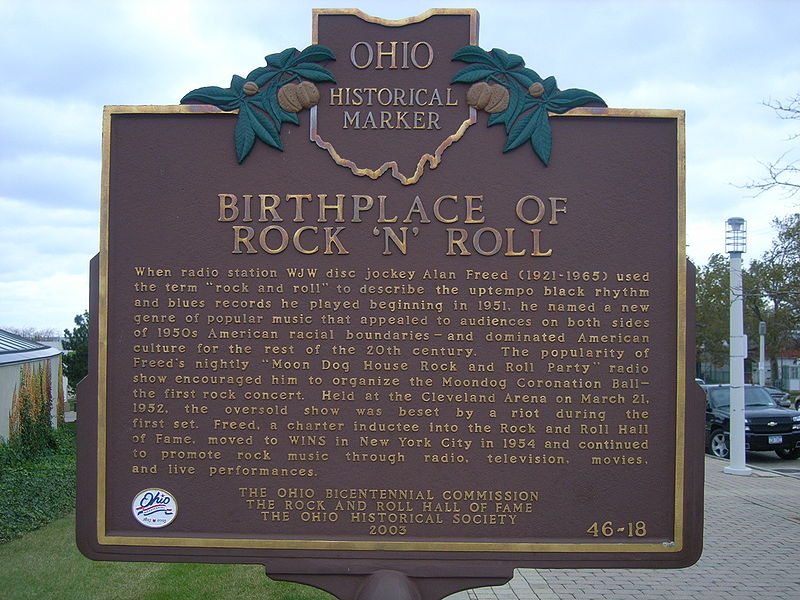|
lemonade kid
Old Love
    
USA
9875 Posts |
 Posted - 08/07/2013 : 16:52:07 Posted - 08/07/2013 : 16:52:07


|
quote:
Originally posted by rocker
Picked up an old lp yesterday called 'Rock'n'Roll'. Cover shows a gal and guy dancing with a fellow playing the sax. Liner notes say" This Mercury package of Red Prysock and the BEAT is an exciting presentation of "stimulating jazz in the contemporary idiom and is proof of the definition that "Sounds are what one hears....but jazz is what you feel". All this was in '55 in NY. One of the songs' title was 'That's the Groovy Thing". From all this looks like a bit of rock was born out of that 'stimulating jazz in the contemporary idiom'. Just wondering who Red was.
One of the originals...though Red was known for his R&B styled sax playing. That is one of the many genres that combined to make Rock & Roll. He joined Alan Freed's stage shows and as we know, Freed was one of the first to push rock & roll into the forefront.
By the way, those Red Prysock LPs can be quite rare and valuable, if NM condition....& not reissues.
And...FATS DOMINO was definitely one of the earliest fathers of Rock & Roll.
Fats Domino
Domino first attracted national attention with "The Fat Man" in 1950 on Imperial Records. This song is an early rock and roll record, featuring a rolling piano and Domino doing "wah-wah" vocalizing over a strong back beat. "The Fat Man" sold one million copies by 1953. Fats Domino released a series of hit songs with producer and co-writer Dave Bartholomew, saxophonists Herbert Hardesty and Alvin "Red" Tyler and drummers Earl Palmer and Smokey Johnson. Other notable and long-standing musicians in Domino's band were saxophonists Reggie Houston, Lee Allen, and Fred Kemp, Domino's trusted bandleader. Domino finally crossed into the pop mainstream with "Ain't That A Shame" (1955), which hit the Top Ten, though Pat Boone characteristically hit No. 1 with a milder cover of the song that received wider radio airplay in a racially-segregated era. Domino eventually had 37 Top 40 singles.
Domino released five gold (million-copy-selling) records before 1955. Domino also had 35 Top 40 American hits and has a music style based on traditional rhythm and blues ensembles of bass, piano, electric guitar, drums, and saxophone.
................
Interesting historical and musical facts about Rock & Roll.
Rock and roll (often written as rock & roll or rock 'n' roll) is a genre of popular music that originated and evolved in the United States during the late 1940s and early 1950s, primarily from a combination of African-American genres such as blues, jump blues, jazz, and gospel music, together with Western swing and country music. Though elements of rock and roll can be heard in blues records from the 1920s and in country records of the 1930s, rock and roll did not acquire its name until the 1950s.
The term "rock and roll" now has at least two different meanings, both in common usage: referring to the first wave of music that originated in the mid-1950s and later developed into the more encompassing international style known as "rock music", and as a term simply synonymous with rock music in the broad sense.
In the earliest rock and roll styles of the late 1940s and early 1950s, either the piano or saxophone was often the lead instrument, but these were generally replaced or supplemented by guitar in the middle to late 1950s. The beat is essentially a blues rhythm with an accentuated backbeat, the latter almost always provided by a snare drum. Classic rock and roll is usually played with one or two electric guitars (one lead, one rhythm), a string bass or (after the mid-1950s) an electric bass guitar, and a drum kit. Beyond simply a musical style, rock and roll, as seen in movies and on television, influenced lifestyles, fashion, attitudes, and language. It went on to spawn various sub-genres, often without the initially characteristic backbeat, that are now more commonly called simply "rock music" or "rock"...wiki

Rock on....
Origins of the phrase...ROCK & ROLL:
The phrase "rocking and rolling" originally described the movement of a ship on the ocean, but was used by the early twentieth century, both to describe the spiritual fervor of black church rituals and as a sexual analogy. Various gospel, blues and swing recordings used the phrase before it became used more frequently – but still intermittently – in the 1940s, on recordings and in reviews of what became known as "rhythm and blues" music aimed at a black audience. In 1942, Billboard magazine columnist Maurie Orodenker started to use the term "rock-and-roll" to describe upbeat recordings such as "Rock Me" by Sister Rosetta Tharpe. By 1943, the "Rock and Roll Inn" in South Merchantville, New Jersey, was established as a music venue. In 1951, Cleveland, Ohio disc jockey Alan Freed began playing this music style while popularizing the phrase to describe it.
The origins of rock and roll have been fiercely debated by commentators and historians of music. There is general agreement that it arose in the Southern United States – a region which would produce most of the major early rock and roll acts – through the meeting of various influences that embodied a merging of the African musical tradition with European instrumentation. The migration of many former slaves and their descendants to major urban centers like Memphis and north to New York City, Detroit, Chicago, Cleveland and Buffalo (See: Second Great Migration (African American)) meant that black and white residents were living in close proximity in larger numbers than ever before, and as a result heard each other's music and even began to emulate each other's fashions. Radio stations that made white and black forms of music available to both groups, the development and spread of the gramophone record, and African American musical styles such as jazz and swing which were taken up by white musicians, aided this process of "cultural collision".
The immediate roots of rock and roll lay in the rhythm and blues, then called "race music", and country music of the 1940s and 1950s. Particularly significant influences were jazz, blues, gospel, country, and folk. Commentators differ in their views of which of these forms were most important and the degree to which the new music was a re-branding of African American rhythm and blues for a white market, or a new hybrid of black and white forms.
In the 1930s jazz, and particularly swing, both in urban based dance bands and blues-influenced country swing, was among the first music to present African American sounds for a predominantly white audience. The 1940s saw the increased use of blaring horns (including saxophones), shouted lyrics and boogie woogie beats in jazz based music.
During and immediately after World War II, with shortages of fuel and limitations on audiences and available personnel, large jazz bands were less economical and tended to be replaced by smaller combos, using guitars, bass and drums. In the same period, particularly on the West Coast and in the Midwest, the development of jump blues, with its guitar riffs, prominent beats and shouted lyrics, prefigured many later developments. In the documentary film Hail! Hail! Rock 'n' Roll, Keith Richards proposes that Chuck Berry developed his brand of rock and roll, by transposing the familiar two-note lead line of jump blues piano directly to the electric guitar, creating what is instantly recognizable as rock guitar. Similarly, country boogie and Chicago electric blues supplied many of the elements that would be seen as characteristic of rock and roll.
Rock and roll arrived at a time of considerable technological change, soon after the development of the electric guitar, amplifier and microphone, and the 45 rpm record. There were also changes in the record industry, with the rise of independent labels like Atlantic, Sun and Chess servicing niche audiences and a similar rise of radio stations that played their music. It was the realization that relatively affluent white teenagers were listening to this music that led to the development of what was to be defined as rock and roll as a distinct genre.
Because the development of rock and roll was an evolutionary process, no single record can be identified as unambiguously "the first" rock and roll record. Contenders for the title of "first rock and roll record" include Goree Carter's "Rock Awhile" (1949); Jimmy Preston's "Rock the Joint" (1949), which was later covered by Bill Haley & His Comets in 1952; and "Rocket 88" by Jackie Brenston and his Delta Cats (backed by Ike Turner and his band The Kings of Rhythm), recorded by Sam Phillips for Sun Records in March 1951. In terms of its wide cultural impact across society in the US and elsewhere, Bill Haley's "Rock Around the Clock", recorded in April 1954 but not a commercial success until the following year, is generally recognized as an important milestone, but it was preceded by many recordings from earlier decades in which elements of rock and roll can be clearly discerned. Other artists with early rock and roll hits included Chuck Berry, Bo Diddley, Fats Domino, Little Richard, Jerry Lee Lewis, and Gene Vincent. Chuck Berry's 1955 classic "Maybellene" in particular features a distorted electric guitar solo with warm overtones created by his small valve amplifier. However, the use of distortion was predated by Guitar Slim, Willie Johnson of Howlin' Wolf's band, and Pat Hare; the latter two also made use of distorted power chords in the early 1950s. In addition, Bo Diddley introduced a new beat and unique electric guitar style, heavily influenced by African music and in turn influencing many later artists.
Though Ohio claims to be the birthplace of ROCK & ROLL (NOT!) and that their native son, Alan Freed, originated the term ROCK & ROLL (also NOT!)...though Freed's immense importance to the genre is undisputed....& his early use of the phrase ROCK AND ROLL constantly on-air, & his groundbreaking rock & roll shows and tours, certainly made Freed one of the key... groundbreakers.
Sign commemorating Ohio's & Alan Freed's role in the development of Rock & Roll

________________________________________________
Old hippies never die, they just ramble on.
-lk |
Edited by - lemonade kid on 09/07/2013 15:51:50 |
 |
|


